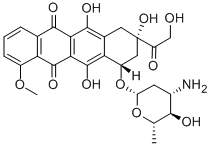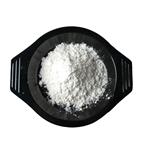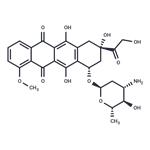
Epirubicin
- Product NameEpirubicin
- CAS56420-45-2
- CBNumberCB8113751
- MFC27H29NO11
- MW543.52
- MDL NumberMFCD01713214
- MOL File56420-45-2.mol
- MSDS FileSDS
Chemical Properties
| Boiling point | 617.77°C (rough estimate) |
| Density | 1.3783 (rough estimate) |
| refractive index | 1.6400 (estimate) |
| storage temp. | Store at -20°C |
| solubility | Soluble in DMSO |
| pka | 7.35±0.60(Predicted) |
| FDA UNII | 3Z8479ZZ5X |
| ATC code | L01DB03 |
Safety
| Hazardous Substances Data | 56420-45-2(Hazardous Substances Data) |
| Toxicity | LD50 intravenous in dog: 2mg/kg |
Epirubicin Price
| Product number | Packaging | Price | Product description | Buy |
|---|---|---|---|---|
| Usbiological 293398 | 10mg | $389 | Epirubicin |
Buy |
| American Custom Chemicals Corporation API0002567 | 5MG | $490 | EPIRUBICIN 95.00% |
Buy |
| American Custom Chemicals Corporation API0002567 | 10MG | $580 | EPIRUBICIN 95.00% |
Buy |
| American Custom Chemicals Corporation API0002567 | 25MG | $850 | EPIRUBICIN 95.00% |
Buy |
| AvaChem 2020B | 1g | $525 | Epirubicin |
Buy |
Epirubicin Chemical Properties,Usage,Production
Originator
Ellence,Pharmacia and Upjohn Co.Uses
Antineoplastic.Uses
Epirubicin is a cell permeable Topo II inhibitor.Definition
ChEBI: An anthracycline that is the 4'-epi-isomer of doxorubicin.Manufacturing Process
Conversion of daunorobicin hydrochloride to 4'-epi-doxorubicin hydrochloride employing the trifluoroacetyl moiety for the 3'-amino group protection:To a solution of 8 g (14 mmol) of daunorubicin hydrochloride in 500 ml of dry MeOH, 5.9 ml (79 mmol, 5.6 eq.) of acetylchloride was added. After refluxing for 1 h the solvents were evaporated in vacuo. Addition of CHCl3 to the residue caused precipitation of daunosamine. After the aminosugar had been filtered off, the filtrate was evaporated in vacuo. Diisopropylether was added to the remaining solid and the mixture was sonicated for 15 min to yielddaunomycinone. In total, 2.55 g (91%) of daunosamine (4-amino-6-methoxy- 2-methyltetrahydropyran-3-ol hydrochloride) and 5.5 g (99%) of daunomycinone were obtained, m.p. 209-233°C (dec.).
Under an argon atmosphere, a solution of 1.24 ml (2.5 eq.) of Br2 in 72.8 ml CHCl3 was added to a solution of 3.90 g (9.8 mmol) of daunomycinone in 390 ml of CHCl3. After stirring the reaction mixture over night at room temperature, the pure bromide 4 precipitated and was filtered out. Yield 4.1 g (88%).The bromide was dissolved in 1.17 L of acetone, 16.7 g of AcOK was added to the mixture which was then refluxed for 5 min. Thereafter the solvents were evaporated in vacuo. The residue was dissolved in CHCl3 and washed with water and brine. The combined organic extracts were dried over Na2SO4, filtered and concentrated in vacuo. Diisopropylether was added and the mixture was sonicated and filtrated to give doxorubicinone acetate, 3.8 g (97%), m.p. 226-229°C (dec.).
Daunosamine modification:
To a solution of 2.55 g (12.9 mmol) of daunosamine in 64 ml of dry diethylether under an argon atmosphere 5 ml (4.8 eq.) of pyridine was added. The reaction mixture was cooled to -20°C and 3.63 ml of trifluoroacetic acid anhydride was added. After stirring overnight at room temperature, the mixture was filtered and the filtrate was washed with diethylether. The filtrate was subsequently washed with 10% citric acid solution, saturated NaHCO3 and brine. The combined extracts were dried over MgSO4, filtrated and evaporated in vacuo. The residue was purified by flash column chromatography (5% MeOH in CHCl3) to give 2.69 g (81%) of (3-hydroxy-6-methoxy-2- methyltetrahydropyran-4-yl)carbamic acid trifluoromethyl ester, m.p. 137- 152°C.
To a solution of 2.5 g (9.7 mmol) of (3-hydroxy-6-methoxy-2- methyltetrahydropyran-4-yl)carbamic acid trifluoromethyl ester in 100 ml of CH2Cl2 2.45 g (11.4 mmol) of pyridinium chlorochromate (PCC) was added. After 2 and after 4 hours of refluxing 1.08 g (5.0 mmol) of PCC was added. Again after refluxing the reaction mixture for 8 hours 1.5 g (7.0 mmol) of PCC was added and the mixture was stirred over night. The mixture was poured into 436 ml of diethylether, filtered and evaporated in vacuo. The residue was purified by flash column chromatography (2% acetone in CH2Cl2) to give 2.10 g (85%) of (6-methoxy-2-methyl-3-oxotetrahydropyran-4-yl)-carbamic acid trifluoromethyl ester, m.p. 74-98°C.
10 ml of 1 M BH3·THF was added dropwise to a solution of 2.6 g (10 mmol) of (6-methoxy-2-methyl-3-oxotetrahydropyran-4-yl)carbamic acid trifluoromethyl ester dissolved in a mixture of 200 ml of dry THF and 125 ml of dry MeOH under an argon atmosphere at 0°C. After stirring for 10 min, 1 ml of H2O was added and the solvents were evaporated in vacuo. The remaining oil was purified by flash column chromatography (3% MeOH in CH2Cl2) to give 2.08 g (80%) of 4'-epidaunosamine derivative as a white solid, m.p. 165-167°C. A solution of 2.08 g (8.1 mmol) of 4'-epidaunosamine derivative in 20% of AcOH was refluxed for 3 hours at 90°C. The solution was freeze-dried and purified by flash column chromatography (10% MeOH in CH2Cl2) to give 1.38 g (70%) of hemiacetal, m.p. 180-185°C.
3.3 ml (23.5 mmol) of trifluoroacetic anhydride was added to a stirred suspension of 272 mg (1.12 mmol) of hemiacetal in 10 ml of dry diethylether under an argon atmosphere at 0°C. After the suspension had become clear, stirring was continued for 1 hour at room temperature, after that the solvent was cautiously removed in vacuo. To this residue 50 ml of dry CH2Cl2 and 10 g of 4 ANG molsieves and 0.27 ml (1.39 mmol) of trimethylsilyl trifluoromethanesulfonate were added under an argon atmosphere at 0°C. The reaction mixture was stirred at 0°C for 1 h and a solution of 0.50 g (1.11 mmol) of doxorubicinone acetate in 100 ml of dry CH2Cl2 was added. After stirring for 2 hours at room temperature, the red suspension was poured into a vigoriously stirred solution of saturated NaHCO3 and the aqueous layer was extracted with CH2Cl2. The combined organic extracts were washed with brine and dried over Na2SO4, filtered and the solvents were evaporated in vacuo. The remaining red solid was stirred overnight in a mixture of 20 ml of CH2Cl2 and 175 ml of MeOH under an argon atmosphere and the solvents were evaporated in vacuo. The remaining red solid was purified by flash column chromatography (4% MeOH in CH2Cl2) to give 345 mg (47%) of 4'- epidoxorubicin derivative, [122 mg (24%) of unreacted doxorubicinone acetate was also obtained; m.p. 114-126°C].
225 ml of saturated NaHCO3 was added to a solution of 784 mg (1.15 mmol) of 4'-epidoxorubicin in a mixture of 150 ml of acetone and 75 ml of methanol under an argon atmosphere. After stirring for 3 hours at room temperature, the purple suspension was poured into 600 ml of H2O and was extracted 3 times with CHCl2. The combined organic extracts were washed with brine, dried over Na2SO2, filtered and taken to dryness in vacuo to give 526 mg (72%) of deacetylated compound, m.p. 147-162°C (dec.).
5.1 ml (42 mmol) of 2,2-dimethoxypropane and 1 mg p-toluene sulfonic acid were added to a solution of 107 mg (0.17 mmol) of deacetylated compound in a mixture of 1 ml of dioxane and 20 ml of CHCl3 under an argon atmosphere. After stirring for 24 hours at room temperature, 10 mg of NaHCO2 was added and the solution was stirred for 5 min. The red reaction mixture was washed with water until neutral pH. The organic layer was washed with brine, dried over Na2SO4, filtered and evaporated in vacuo. The remaining red solid was purified by flash column chromatography (5% MeOH in CH2Cl2) to give 86 mg (72%) of compound with protected carbonyl group (a mixture of diastereomers), m.p.146-164°C.
A solution of 325 mg (0.46 mmol) of above compound in a mixture of 50 ml of 0.1 M NaOH and 10 ml of acetone was stirred for 30 min at room temperature under an argon atmosphere. The pH of the reaction mixture was adjusted to 8.4 with a 0.1 M HCl solution and extracted with CHCl3 until the organic layer was colourless. The combined organic extracts were dried over Na2SO4, filtered and the solvent was evaporated in vacuo. The residue was dissolved in 20 ml of 0.1 M HCl and stirred for 39 hours at room temperature, the solution was then washed with CHCl3 (to extract the aglycone). The pH of the combined aqueous layer was adjusted to 8.5 with 0.1 M NaOH and extracted with CHCl2 until the organic extract was colourless. The combined organic extracts were dried over Na2SO4, filtered and the solution was concentrated. Diethylether and 0.76 ml of 0.6 M HCl in MeOH were added, 4'-epidoxorubicin hydrochloride precipitated and was filtrated to obtain 118 mg (45%), m.p. 176-185°C (dec.).
brand name
Ellence(Pfizer).Therapeutic Function
AntineoplasticPreparation Products And Raw materials
Epirubicin Supplier
Global(185)Suppliers
| Supplier | Tel | Country | ProdList | Advantage | |
|---|---|---|---|---|---|
| +86-15531157085 +86-15531157085 |
abby@chuanghaibio.com | China | 8805 | 58 | |
| +86 13288715578 +8613288715578 |
sales@hbmojin.com | China | 12826 | 58 | |
| +8618092446649 | sarah@tnjone.com | China | 1143 | 58 | |
| +86-0371-86658258 +8613203830695 |
sales@coreychem.com | China | 29866 | 58 | |
| 0086-13720134139 | candy@biochempartner.com | CHINA | 965 | 58 | |
| +1-631-485-4226 | inquiry@bocsci.com | United States | 19552 | 58 | |
| +86-023-6139-8061 +86-86-13650506873 |
sales@chemdad.com | China | 39894 | 58 | |
| +8618523575427 | sales@conier.com | China | 49732 | 58 | |
| +8613367258412 | ada@ipurechemical.com | China | 10319 | 58 | |
| +86-0551-65418671 +8618949823763 |
sales@tnjchem.com | China | 34563 | 58 |
56420-45-2, EpirubicinRelated Search
PROMPT×
PROMPT
The What'sApp is temporarily not supported in mainland China
The What'sApp is temporarily not supported in mainland China
Cancel
Determine


